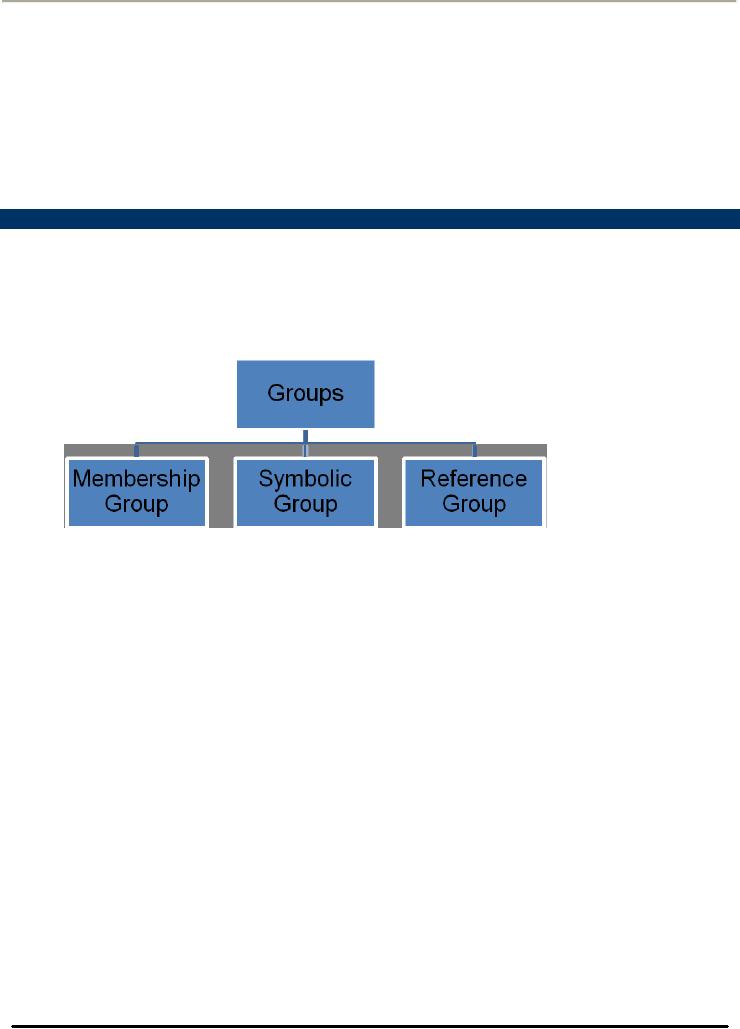 |

Consumer
Psychology (PSY -
514)
VU
LESSON26
CONSUMER
SOCIAL CLASSES
CHAPTER
4: ENVIRONMENTAL INFLUENCES
�
Understanding:
Groups
�
Reference
Groups
�
Working
Class
�
Non
Affluent Consumers
Consumer
Related Reference
Groups
A
group may be defined as two
or more people who interact with
each other to accomplish
individual or mutual
goals
e.g. group of two neighbors,
the local cricket club, the boys' hockey
team of a colony, group of friends
from
college,
group of cousins
Types
of Groups
Mainly
three types of groups may be
differentiated:
1.
Membership Group
A
group to which either a person
belongs or would qualify for
membership is called a membership
group. The
group
of men with whom a young
executive plays chess every
week is his membership
group
2.
Symbolic Group
Group
in which an individual is not
likely to receive membership
despite acting like member
by adopting the
group's
values, attitudes and
behaviors is called a Symbolic
Group. Professional cricket players
may constitute a
symbolic
group for an amateur who
identifies with certain players by
imitating their behavior,
e.g. by buying a
certain
brand of racket or wearing a certain
kind if T-Shirt but he will
never get the membership as a
professional
player
3.
Reference Group
Any
group or a person that
serves as a point of comparison
(reference) for an individual in
forming either general
or
specific values, attitudes or a
specific guide for behavior.
Reference Group provides valuable
perspective for
understanding
the impact of other people on
individual's consumption beliefs, values,
attitudes and behavior.
Also
provides
insights into the methods
marketers use to affect desired
changes in the Consumer Behavior.
Reference
groups
serve as frames of reference
for individuals in their
purchase or consumption decisions.
Usefulness
of the Concept of reference group is
enhanced by the facts that it
places no restriction on group size
or
membership,
nor does it require that
consumers identify with a tangible group.
The group can be symbolic
e.g.
owners
of successful businesses, leading
corporate chief executives, music stars,
cricket celebrities, etc...
83

Consumer
Psychology (PSY -
514)
VU
Types
of Reference Groups
Two
types of Reference Groups
may be identified:
�
Normative
Reference Group
�
Comparative
Reference Group
�
Indirect
Reference Grfoup
Normative
Reference Group
Reference
groups that influence general or
broadly defined values or
behavior are called
Normative Reference
Groups.
Child's normative reference group is
his immediate family, which
is likely to play important role
in
modeling
the child's general consumer values
and behavior (such as which
foods to select, what clothes to
wear,
etc...)
Normative Reference group influence the
development of a basic code of
behavior.
Comparative
Reference Group
Reference
groups that serve as
benchmarks for specific
narrowly defined attitudes or
behavior are called
Comparative
Reference Groups. Example: A neighboring
family whose lifestyle appears to be
admirable and
worthy
of imitation (the way they maintain their
home, their choice of
furniture, cars, their taste
in clothing).
Comparative
groups influence the expression of
specific consumer attitudes
and behaviors. It is likely
that the
specific
influences of comparative reference
groups to some measure
depend upon the basic values
and behavior
patterns
established early in a person's
development by normative reference
groups
Indirect
Reference Group
The
meaning of reference groups
has changed over the years.
Originally reference groups
were narrowly defined
to
include
only the groups with which a
person interacted. IRC
consists of those groups or
individuals with whom
a
person
does not have direct face to
face contact such as movie
stars, sports heroes,
political leaders,
etc..
Factors
Affecting Reference Group
Influence
Following
factors affect the influence of the Reference
Groups
1.
Information and Experience
First
hand experience with a product or
service, or can easily
obtain first hand information about
it, is less likely to
be
influenced by the advice or influence of the others.
Person who has little or no
experience with a product
or
service
is more likely to seek out
the advice or example of
others
For
example, a young corporate sale
representative who wants to
impress his client may
take him to restaurant;
he
knows
is good or the one that is
highly recommended by the local
newspaper. In case of none of the above
he may
seek
the advice of a friend or a parent. He
imitates the behavior of others by
taking him to a restaurant he knows
is
frequented
by the business executives he
admires.
Credibility,
Attractiveness and Power
A
reference group considered as
credible, attractive and powerful
may induce consumer attitude
and behavior
change.
Consumers who seek accurate
information are likely to be
persuaded by whom they consider
trustworthy
or
knowledgeable- that is more
likely to be persuaded by sources
that are credible.
Consumers
Concern with Approval
84

Consumer
Psychology (PSY -
514)
VU
Consumers
are primarily concerned with
acceptance or approval of others whom
they like or with whom
they
identify,
or those who offer them
status or other benefits. T
hey are likely to adopt
their product, brand or
other
behavioral
characteristics.
Concern
with Power
When
consumers are primarily
concerned with power that a
person or group can exert
over them they might
chose
a product that confirm to the
norms of that person or
group in order to avoid punishment or
ridicule
Conspicuousness
of the Product
Influence
of reference group on purchase
decision varies with
reference to how conspicuous the
product is to
others
Visually
Conspicuous product
is the one that stands out
and gets noticed e.g. a
luxury item or novelty
product.
Verbally
Conspicuous Product may be
highly interesting; it may be easily
described to others
Especially
Conspicuous Products are
status revealing such as new
automobile, laptop computer, fashion
clothing,
etc...are most likely to be
purchased with eye on the reaction of
significant others
Privately
consumed products that are
less conspicuous (shaving
cream or bath soap) are less
likely to be purchased
with
reference groups in mind. Marketers
especially market leaders
are interested in the ability of
reference groups
to
change consumer attitudes
and behavior by encouraging
conformity.
Targeting
Conformity
To
influence conformity, a reference group
must accomplish the
following:
�
Inform
or make the individual aware of a
specific product or brand
�
Provide
individual with the opportunity to
compare his/her own thinking
with the attitudes and
behaviors
of
others
�
Influence
the individual to adopt the attitudes
that are consistent with the
norms of the group
�
Legitimize
the decision to use the same products as
groups
New
Brand Marketing
One
may wish to elect a strategy
that asks consumers to strike
out and be different and
not just follow the crowd
when
making a purchase decision. In reality the
non-conformity appeal can be
thought of as a request to
shift
one's
reference (attitude or behavior) from
one grouping to another
reference.
Selected
Consumer Reference
Groups
Friendship
Groups are classified as
informal groups because they
are unstructured and lack
authority structure.
Friends
are only second to one's
family in influencing. Seeking
and maintaining friendship is a basic
need/drive for
most
people. Friends provide
comfort, love and companionship.
Most of all they provide
opportunity o discuss
things
that one can't discuss
with relatives or
family.
The
opinions and preferences of friends
are important influences in determining
the brands a consumer
ultimately
selects
Workgroups
The
importance of workgroups can be understood by the
sheer amount of time that people spend at
jobs.
Distinction
can be made between formal
and informal workgroups.
Formal
Workgroups consist
of individuals who work together as
part of team and thus
have a sustained
opportunity
to influence each others
opinions
85

Consumer
Psychology (PSY -
514)
VU
Informal
Workgroups consist
of individuals who have
become friends as a result of working
for the same firm.
Members
of the informal workgroups may influence
behavior during the coffee and
lunch hours or after
work
meetings.
86
Table of Contents:
- INTRODUCTION TO CONSUMER PSYCHOLOGY:Consumer Behavior
- INTRODUCTION TO CONSUMER PSYCHOLOGY:Consumer research
- INTRODUCTION TO CONSUMER PSYCHOLOGY:Marketing Mix, Product, Price
- INTRODUCTION TO CONSUMER PSYCHOLOGY:Customer Value, Perceived Value
- VALUE AND RETENTION FOCUSED MARKETING AND CONSUMER DECISION MAKING PROCESS
- CONSUMER RESEARCH:Quantitative Research, Qualitative Research
- MAJOR STEPS IN CONSUMER RESEARCH PROCESS:Design of Primary research
- QUANTITATIVE RESEARCH DESIGNS & DATA COLLECTION METHODS
- QUANTITATIVE RESEARCH DATA COLLECTION TECHNIQUES:ATTITUDE SCALES
- QUALITATIVE RESEARCH DESIGNS & DATA COLLECTION METHODS
- CUSTOMER SATISFACTION MEASUREMENT, SAMPLING, AND DATA ANALYSIS AND REPORTING
- MARKET SEGMENTATION AND ITS BASES:Geographical Segmentation
- BASES FOR SEGMENTATION: DEMOGRAPHIC SEGMENTATION PSYCHOGRAPHIC SEGMENTATION
- BASES FOR SEGMENTATION: SOCIOCULTURAL SEGMENTATION USE RELATED SEGMENTATION USAGE SITUATION SEGMENTATION
- BASES FOR SEGMENTATION: BENEFIT SEGMENTATION:Intrinsic Cues
- BASES FOR SEGMENTATION: HYBRID SEGMENTATION STRATEGIES
- MARKET SEGMENTATION IMPLEMENTING SEGMENTATION STRATEGIES ENVIRONMENTAL INFLUENCES CULTURE
- HOW CULTURE IS LEARNT ENVIRONMENTAL INFLUENCES:Formal Learning
- CULTURE AND ITS MEASUREMENT ENVIRONMENTAL INFLUENCES
- MEASUREMENT OF CULTURE ENVIRONMENTAL INFLUENCES:Consumer Fieldwork
- SUBCULTURE CHAPTER 4: ENVIRONMENTAL INFLUENCES
- AGE AND GENDER SUBCULTURE CHAPTER 4: ENVIRONMENTAL INFLUENCES
- BASES FOR SEGMENTATION: BENEFIT SEGMENTATION:Market Segmentation
- SOCIAL CLASS CHAPTER 4: ENVIRONMENTAL INFLUENCES:Occupation
- CONSUMER SOCIAL CLASSES CHAPTER 4: ENVIRONMENTAL INFLUENCES:Affluent Consumer
- CONSUMER SOCIAL CLASSES CHAPTER 4: ENVIRONMENTAL INFLUENCES:Membership Group
- CONSUMER SOCIAL CLASSES CHAPTER 4: ENVIRONMENTAL INFLUENCES:Shopping Groups
- UNDERSTANDING PERSONALITY CHAPTER 5: INDIVIDUAL DETERMINANTS OF CONSUMER BEHAVIOR
- CONSUMER PERSONALITY, TRAIT THEORY AND SELF IMAGES
- CONSUMER MOTIVATION:Needs, Goals, Generic Goals
- UNDERSTANDING LEARNING:Intentional and Incidental Learning, Implications for Marketers
- INSTRUMENTAL CONDITIONING, INFORMATION PROCESSING AND MEMORY
- ATTITUDES:Characteristics of Attitudes, Attitudes have consistency
- ATTITUDE FORMATION AND CHANGE:How attitudes are learned?
- ATTITUDE CHANGE STRATEGIES:Resolving two conflicting attitudes
- INTRODUCTION TO CONSUMER DECISION MAKING:Decision Complexity
- Problem Recognition, Search and Evaluation and Decision and Purchase
- Decision and Purchase:Consumer Decision Rules, Output, Relationship Marketing
- Decisions Related to Post Purchase:Product Set up and Use
- Marketing Implications of Decisions Related to Post Purchase:Understanding
- Post Purchase Evaluation:Determinants of Satisfaction, Consumer Complaint Behavior
- Post Purchase Dissonance:Dissonance Reduction, Marketing Implications
- Consumerism:Roots of Consumerism, The Nature of Consumerism
- Consumerism – Issues and Responses:Environmental Concerns, Consumer Privacy
- Review – Consumer Psychology Course:Consumer Research, Consumerism